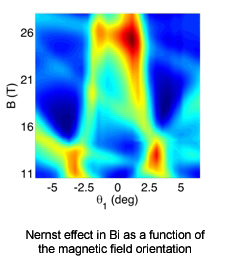Strongly correlated and low dimensionality electronic systems
In the 1950s, Landau proposed a Fermi liquid model that, following a
series of spectacular successful predictions, became the standard model
for metals. This model breaks down when strong electronic correlations
enter the game. Many transition-metal oxides as well as heavy fermion
compounds enter this strong fermionic correlation category. Deviations
from the standard Landau model also appear in low dimensionality (1D and
2D) systems as well as in systems semi-metals which have an extremely
low carrier density. In particular, exotic effects appear when these
semi-metals are submitted to a strong magnetic field.
All of these topics are tackled at LPEM through diverse experimental
probes: dc and ac conductivity, determination of thermoelectric
coefficients, magnetic properties, NMR, and local probe microscopy.
Amongst the most relevant results obtained at the laboratory, it is
worth mentioning the charge and entropy transport work on semi-metals,
such as Bi and BiSb, beyond the quantum limit. Giant anomalies,
previously unconceivable in 3D systems, were observed at magnetic fields
which correspond to fractionary Landau levels. A detailed analysis of
this complex system leads to a rich and unexpected new physics. It might
be the signature of a new class of materials: topological insulators,
where surface states are important even in the 3D case.

We also study magnetic compounds, such as manganites and multiferroic
materials (where an electric order coexists with the magnetic). We are
interesting in understanding their rich phase diagram in which orbital,
charge and spin orders coexist and where the lattice acts as an
important meddling partner. A recent study on multiferroic BiFeO3 has
shown the importance of the lattice in the coupling of magnetic and
electric properties. Phase separations in manganites were highlighted by
NMR measurements. Local electrostatic force microscopy in these
compounds showed the sub-micron spatial organization of the coexisting
phases and evidenced their dynamic response as a function of the sample
thermo-magnetic history.
At last, but not least, we study the superconducting fluctuations in
cuprates and disordered systems. We recently showed that conventional
Gaussian fluctuations properly account for the underdoped cuprates
behavior, in contrast to dominating theoretical predictions. In
addition, we established, for the first time, the very close agreement
between theory and BCS superconducting fluctuations by Nernst effect.
The laboratory has several original and complementary experimental
facilities:
- Coherent, incoherent and magneto electrical transport can be spectroscopically probed by visible and infrared absorption, electronic Raman diffusion, near field infrared, tunneling, Nernst effect and thermal transport.
- Local electronic properties can be determined by NMR.
- EPR and NMR probes can look at particular spin dependent conduction electrons properties.
